Suggestions
Use up and down arrows to review and enter to select.Please wait while we process your payment
If you don't see it, please check your spam folder. Sometimes it can end up there.
If you don't see it, please check your spam folder. Sometimes it can end up there.
Please wait while we process your payment

By signing up you agree to our terms and privacy policy.
Don’t have an account? Subscribe now
Create Your Account
Sign up for your FREE 7-day trial
Already have an account? Log in
Your Email
Choose Your Plan
Individual
Group Discount
Save over 50% with a SparkNotes PLUS Annual Plan!
 payment page
payment page
Purchasing SparkNotes PLUS for a group?
Get Annual Plans at a discount when you buy 2 or more!
Price
$24.99 $18.74 /subscription + tax
Subtotal $37.48 + tax
Save 25% on 2-49 accounts
Save 30% on 50-99 accounts
Want 100 or more? Contact us for a customized plan.
 payment page
payment page
Your Plan
Payment Details
Payment Summary
SparkNotes Plus
You'll be billed after your free trial ends.
7-Day Free Trial
Not Applicable
Renews November 28, 2024 November 21, 2024
Discounts (applied to next billing)
DUE NOW
US $0.00
SNPLUSROCKS20 | 20% Discount
This is not a valid promo code.
Discount Code (one code per order)
SparkNotes PLUS Annual Plan - Group Discount
Qty: 00
SparkNotes Plus subscription is $4.99/month or $24.99/year as selected above. The free trial period is the first 7 days of your subscription. TO CANCEL YOUR SUBSCRIPTION AND AVOID BEING CHARGED, YOU MUST CANCEL BEFORE THE END OF THE FREE TRIAL PERIOD. You may cancel your subscription on your Subscription and Billing page or contact Customer Support at custserv@bn.com. Your subscription will continue automatically once the free trial period is over. Free trial is available to new customers only.
Choose Your Plan
For the next 7 days, you'll have access to awesome PLUS stuff like AP English test prep, No Fear Shakespeare translations and audio, a note-taking tool, personalized dashboard, & much more!
You’ve successfully purchased a group discount. Your group members can use the joining link below to redeem their group membership. You'll also receive an email with the link.
Members will be prompted to log in or create an account to redeem their group membership.
Thanks for creating a SparkNotes account! Continue to start your free trial.
We're sorry, we could not create your account. SparkNotes PLUS is not available in your country. See what countries we’re in.
There was an error creating your account. Please check your payment details and try again.
Please wait while we process your payment

Your PLUS subscription has expired
Please wait while we process your payment
Please wait while we process your payment

Inverse Trigonometric Functions
The inverses of the trigonometric functions (x = sin(y), x = cos(y), etc.) aren't functions, they are relations. The reason they are not functions is that for a given value of x, there are an infinite number of angles at which the trigonometric functions take on the value of x. Thus, the range of the inverses of the trigonometric functions must be restricted to make them functions. Without these restricted ranges, they are known as the inverse trigonometric relations.
The six inverse trigonometric functions are arcsine, arccosine, arctangent, arccosecant, arcsecant, and arccotangent. Sometimes they are capitalized to differentiate them from the inverse trigonometric relations. In this text, they will not be capitalized; the distinction will be made clear another way. x = sin(y) is equivalent to y = arcsin(x). This is the way that all of the inverse trigonometric functions are defined. In the chart below are shown the domains and ranges of the inverse trigonometric functions.

Below are pictured the graphs of the six inverse trigonometric relations. Study the restricted ranges that turn these relations into functions, and then locate the sections of the graphs of the relations that become the graphs of the functions. Verify that they are indeed functions.
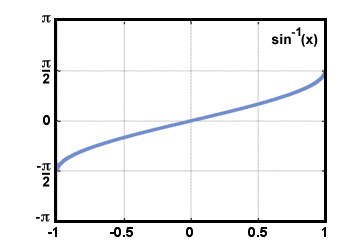
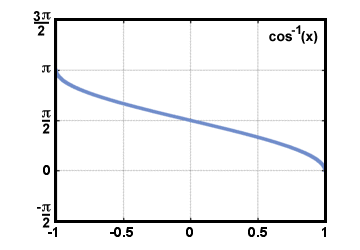
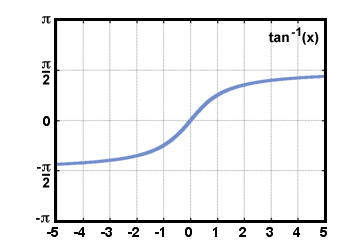
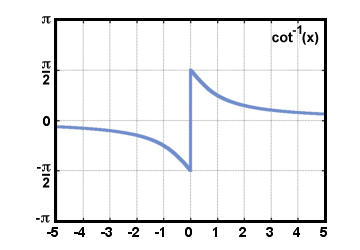
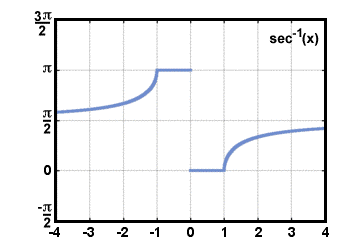
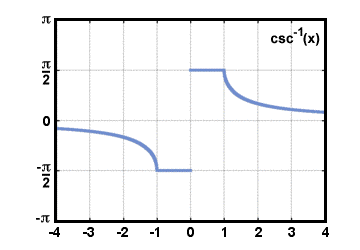
The inverse trigonometric functions are useful in solving wide varieties of trigonometric functions. On calculators, they appear as sin-1, cos-1, tan-1, etc. This symbolism for the inverse of the functions should not be confused with negative exponents.
Please wait while we process your payment

